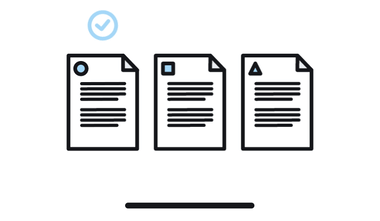We get questions like these all the time, "What happens after I hit submit and apply for that job? Where does my resume go? Does someone actually review it?" And honestly, we get why you'd ask these questions. Especially in a job market as competitive as this one. Applying for jobs can feel like a massive build-up for the applicant. You work your tail off on the application. You update your resume, make sure your portfolio is perfect, and maybe even write a cover letter—only to get an automated “thank you” email followed by…crickets. On the other side, we can promise you, the recruiting process is never simple. But, we want to break down everything that's going on during that quiet time before interviews get scheduled.
Here’s how it works for most recruiters:
Step 1: Initial Screening
We have a wide range of clients that we work with and this process looks different depending on the size of the company. Larger companies tend to use third-party applicant tracking systems, or ATS, that help with every aspect of recruitment, from job posting to screening to scheduling interviews. Some of these ATS programs do use built-in AI to screen large piles of applications in the beginning. (Though our ATS at Artisan never uses AI at any point in the process.) This is one of the many reasons it’s always a good idea to tailor your resume to the job description— in this setting, artificial intelligence is built to pay more attention to skills in the form of keywords, triple-checking that you have the correct qualifications. Once the ATS whittles down the stack of applications, recruiters take the lead, examining both resumes and portfolios to find the best candidates.
Smaller companies may not use an ATS, so it’s up to recruiters to do the initial screening. As applications come in, recruiters scan resumes and look through portfolios to compile a shortlist of applicants. Many recruiters will then hold phone or video call screenings with these applicants to ensure they meet the requirements and can speak about their experience. Depending on their performance, applicants who pass a phone screening may move to the next round.
A note about this part of the process: it can take time. Especially when the market is as competitive as it is now.
Step 2: Compiling the Shortlist
Next, recruiters will compile a shortlist of candidates and present it to the hiring managers or hiring team. Often a recruiter will walk through the candidates on the shortlist, pitching them to the hiring team and mentioning anything of note that came up in their research and phone screening. Once the hiring manager selects who they want to meet with, the recruiter will begin setting up interviews.
Some things to remember during this time: at a big company, there are likely more applicants and so the vetting process will generally be longer than with a smaller company. You may have unknowingly applied after the first round of vetting has already begun. If that’s the case, you could still hear from a larger company a month or two down the line!
Step 3: Scheduling Interviews
Once the hiring manager decides on a core set of people to interview, the recruiter will schedule behavioral, culture-fit, and skill-based interviews. This process looks different for every company with some organizations holding 3+ rounds of interviews while others may only have 1 or 2 rounds. Remember that hiring managers are juggling both their current jobs and the job of hiring others. This is why the timing—especially with smaller companies—can fluctuate. If there is more downtime, the hiring manager will be able to get to interviewing sooner. If it’s a busy time of year or vacation season, you will likely have to wait a little longer.
Many creative interview processes will often involve a creative test. For copywriters, they may ask for a sample with a given prompt. Design roles are often asked to solve a common design problem. At Artisan, we're huge advocates of candidates being paid for these tests but many companies won't make that decision. This is an incredibly controversial part of creative interviews and we understand being uncomfortable with doing work for free. No matter what, as a creative during interviews, you should be ready to have this conversation.
So, what can you do to help the process along?
Three simple things:
-
Be truthful
Wanting a job so badly can often drive people to lie about their qualifications and experience. But for everyone’s sake (and especially yours), don’t do it! Everyone’s time is precious. Industries are small worlds, too, and you don’t want to tarnish your reputation. Plus, we've often found most lies come back to bite candidates in the bum more often than not.
-
Be patient
As we mentioned above, hiring managers and recruiters are extremely busy with multiple workloads and hiring timelines. It’s fine and even encouraged to follow up politely after a week or two weeks if you have not heard anything—but the keyword here is polite. Lead with empathy and, in the meantime, there’s no shame in continuing to job search elsewhere to keep your chances for employment high. Patience also breeds positivity, which you’ll need for all those interviews.
- Build a strong relationship with your recruiter
At Artisan we make it really easy to reach out and keep in touch with recruiters. Need some advice on how to reach out professionally? We got you. If you’re ready to do business, then let’s get started!



